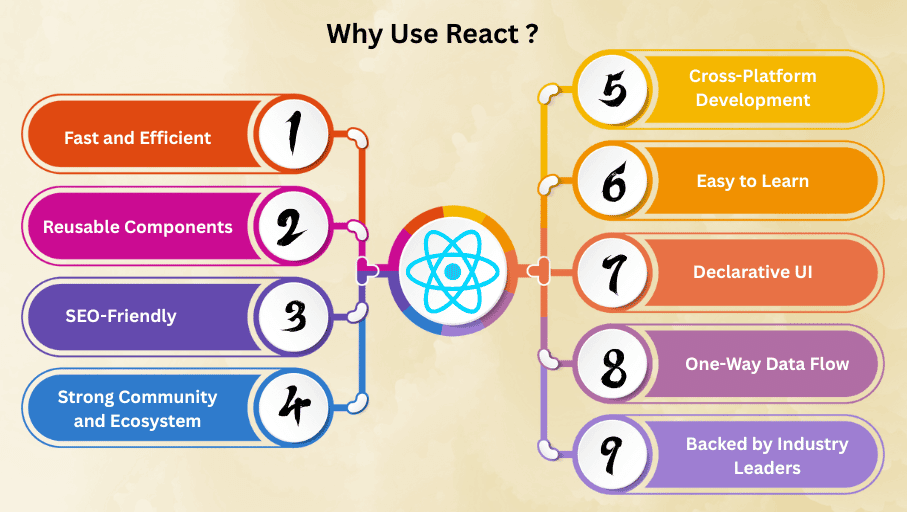What is React?
React is a popular JavaScript library for building modern, fast, and interactive user interfaces (UIs).
Developed by Facebook (now Meta), React allows developers to create dynamic, component-based applications for the web and mobile using React Native.
React focuses on building reusable UI components that efficiently update and render data changes.
Who Created React?
React was created by Jordan Walke, a software engineer at Facebook, in 2011.
It was open-sourced in 2013, quickly gaining global popularity for its performance and simplicity.
React’s main goal was to make building interactive and dynamic user interfaces easier — solving the challenges of updating complex UI elements efficiently using the Virtual DOM.
Why Use React?
React has become one of the most popular JavaScript libraries for web development, and there are several reasons why developers choose it:

| Feature | Description |
|---|---|
| Fast and Efficient | Uses the Virtual DOM to update only changed elements — resulting in high performance and smooth UI transitions. |
| Reusable Components | Component-based architecture lets developers reuse UI blocks, ensuring consistency and faster development. |
| SEO-Friendly | With frameworks like Next.js or Remix, React supports Server-Side Rendering (SSR) for better search engine visibility. |
| Strong Ecosystem & Community | Backed by Meta and a massive open-source community — thousands of tutorials, plugins, and tools are available. |
| Cross-Platform | Build web apps with React and mobile apps with React Native using the same JavaScript logic. |
| Easy to Learn | If you know JavaScript and HTML, you can easily pick up JSX, React’s syntax combining markup and logic. |
| Declarative UI | Describe what your UI should look like — React handles how to update it efficiently. |
| One-Way Data Flow | Data flows from parent to child components, making applications more predictable and easier to debug. |
| Backed by Industry Leaders | Used by companies like Netflix, Airbnb, Instagram, and Facebook, proving React’s scalability and reliability. |
History of React
- 2011: React was created by Jordan Walke, a software engineer at Facebook.
- 2013: React was open-sourced, allowing developers worldwide to use and contribute.
- 2015: React Native was introduced, enabling mobile app development with React.
- Today: React is one of the most popular JavaScript libraries, used by companies like Facebook, Instagram, Netflix, Airbnb, and more.
Why Learn React?
Learning React opens doors to frontend and full-stack web development careers.
- High Demand: React skills are highly sought after in the job market.
- SEO-Friendly: With tools like Next.js, React apps can be optimized for search engines.
- Reusable Components: Saves time and effort while building large-scale applications.
- Cross-Platform Development: Build web apps and mobile apps using React Native.
Points to remember :
- React is a JavaScript library for building interactive UIs.
- Created by Jordan Walke at Facebook in 2011.
- Based on components, Virtual DOM, and one-way data flow.
- Powers websites and mobile apps used by Netflix, Instagram, and Airbnb.
- Learning React helps you become a modern web developer ready for frontend and full-stack roles.

